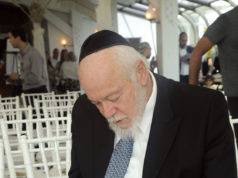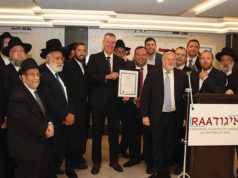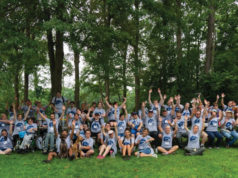
Most people probably tend to associate Mexico more with wide-brimmed straw hats and exotic, heavily spiced food than with Sephardic Jewish observance and culture. Yet, since Mexico City, in a relatively short time, has become a celebrated center of Jewish life, it behooves us to explore it.
A fuller appreciation of the vibrant expression of Jewish life that exists today in Mexico can be gained by taking a glimpse at recent Jewish history in that part of the world. For a few hundred years, Mexican Jewry was forced to live a clandestine existence or suffer persecution at the hands of the Mexican Inquisition. This dark era ended in 1821 when Mexico became an independent state. Although complete religious tolerance did not emerge immediately, there was movement in this direction. Communal Jewish life began to be organized formally around the beginning of the 1900s. This was facilitated by increased immigration of Ashkenazic Jews from Europe and Russia and later, Sephardim from the Middle East. A state of anarchy in the Turkish Empire at that time led many Sephardic and Levantine Jews living there to leave, and many found their way to Mexico since their Ladino tongue and outward appearance eased their acclimation to its people and culture.

In 1912, the first permanent Jewish communal organization was formed in Mexico, the Alianza Monte Sinai (Mount Sinai Alliance). This was a watershed event for the Jewish community in Mexico since it was to provide its constituents with many essential services. Its first courses of action were to establish a system to assist the needy, construct a mikva, and arrange for a shochet, a mohel, and teachers to come to Mexico. With the intervention of President Francisco I. Madero, the community acquired land for the first Jewish cemetery. While in its initial stages, the Alianza Monte Sinai consisted of both Ashkenazim and Sephardim, eventually it became a predominantly Sephardic organization since most of the Jews immigrating to Mexico in the early 20th century were of Sephardic origin. (The Ashkenazi leadership ultimately established their own organizational body to provide for that community’s needs within a framework consistent with their background.)
Since its humble beginnings, Mexico City’s contemporary Sephardic community has grown by leaps and bounds. Its synagogues and institutions are located in basically two colonias (neighborhoods), Polanco and Tecamachalco. In Polanco, these include the large and impressive Magen David Congregation, which actually houses several midrashim. Magen David is essentially an organization which oversees a network of several congregations, and caters to a variety of communal needs including aid to the needy, a health clinic, publications, and kashrut supervision. Magen David was founded by those Sephardim who arrived in Mexico from Aleppo, while today, the Alianza Monte Sinai (which also maintains several synagogues) is under the auspices of those whose origins are from Damascus (whose customs are somewhat different than their Aleppo-born counterparts).
 The foundation of Jewish society in any locale, necessary to allow for the perpetuation of our values and practices, is its educational system. There are numerous schools maintained by the Jewish community of Mexico City which care for the educational needs of the young people, including two excellent Sephardic yeshivot, Ateret Yosef and Keter Torah. A large number of graduates continue with post-high-school studies at yeshivot in Israel and the United States. These future leaders return to their native land to continue to learn and teach, passing along the added knowledge and commitment they have been imbued with abroad.
The foundation of Jewish society in any locale, necessary to allow for the perpetuation of our values and practices, is its educational system. There are numerous schools maintained by the Jewish community of Mexico City which care for the educational needs of the young people, including two excellent Sephardic yeshivot, Ateret Yosef and Keter Torah. A large number of graduates continue with post-high-school studies at yeshivot in Israel and the United States. These future leaders return to their native land to continue to learn and teach, passing along the added knowledge and commitment they have been imbued with abroad.
In addition, there are several institutions which have greatly contributed to the upsurge of religious awareness and practice which has taken place there in the last 15 to 20 years. Most of these are full-time kollelim where avreichim (married scholars) spend the day immersed in Torah learning. In the evenings, these batei midrashim are crowded with working people of varying backgrounds who come to attend classes or learn privately with a study partner. The first of these institutions, Kollel Aram Tzova was established by a visiting Sephardi rav from the US, Chacham Abraham Baddush, A”H. Under his guidance, plans were made by a number of families concerned about the Jewish future in Mexico to establish this pioneering institution which would become an extremely busy center of Torah and tefilla in Polanco. Aram Tzova is under the direction of Chacham David Shweky, sh’lita.
Another important development was the opening of a branch of the international outreach organization TOV (Time Out for Values) in 1985 in the Tecamachalco section. Its charismatic director, Dr. Isaac Betech, has emerged not only as one of the leading Torah lecturers in the Mexican Jewish community, but has also brought his inspiring seminars abroad to audiences in the United States, South America, Spain and Austria. Besides a full schedule of shiurim (Torah classes) by Dr. Betech and other scholars, TOV offers a cassette-lending library and maintains a web site featuring Torah thoughts (http://ourworld.compuserve.com/homepages/tovnet).
The Jewish community in Mexico City also has its equivalent to New Jersey’s Deal vacation area and New York’s Catskill Mountains in a town called Cuernavaca, about 1¼ hours by car from Mexico City. Here, one finds a number of “conjuntos” (loosely translated: colonies) which contain sturdy, well-built houses designed for use throughout the year, considering Cuernavaca’s perennially warm climate, and that the air is much clearer than in smog-ridden Mexico City. These conjuntos have one or more pools, recreational facilities, and a beit midrash offering daily minyanim and learning sessions.
At this point it should be evident that there exists a strong common denominator between the Sephardic community of Mexico City and those elsewhere as far as priorities and interests are concerned. Such knowledge is valuable because it inspires us towards strengthening our bond with Torah and our fellow Jews wherever we are.
__________
Yosef Gesser is a freelance writer currently residing in Brooklyn, who formerly lived in Mexico.



